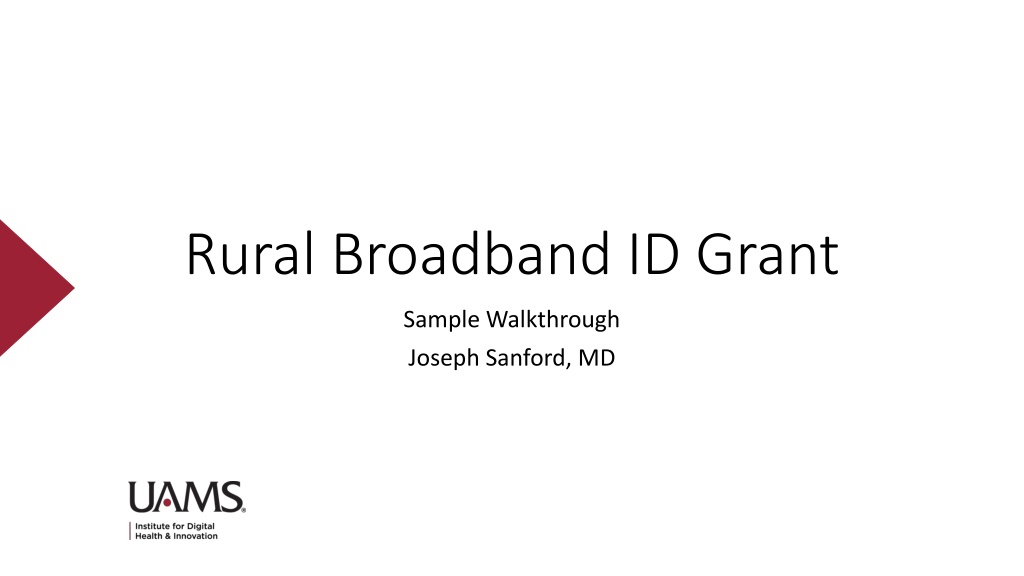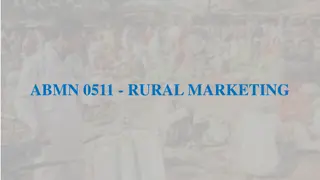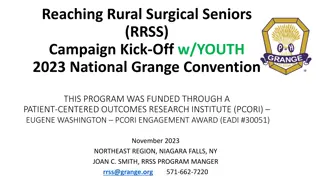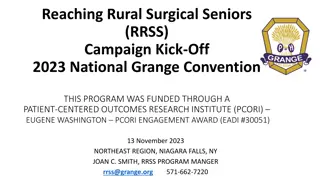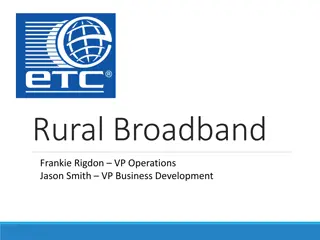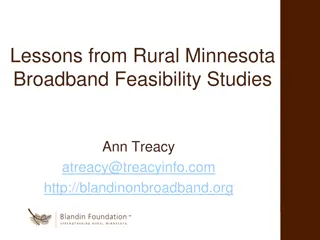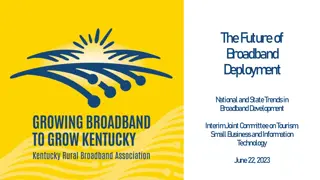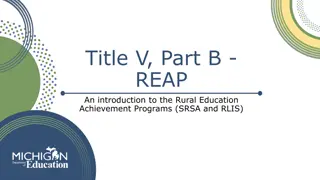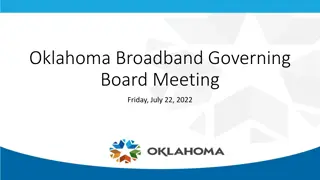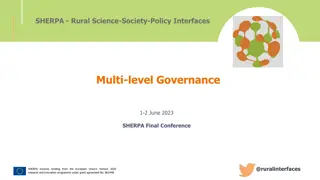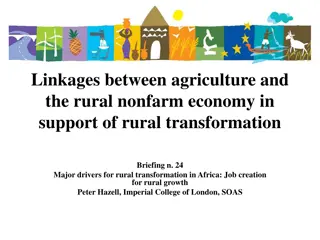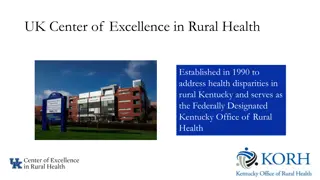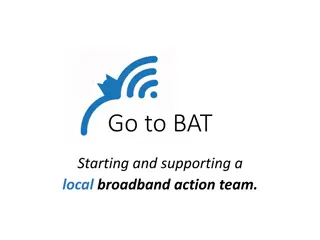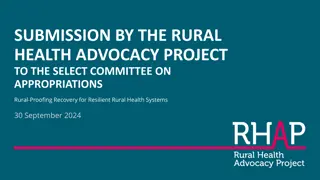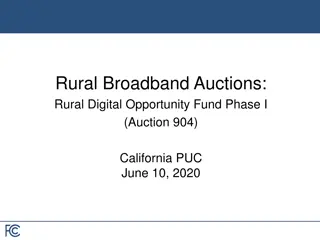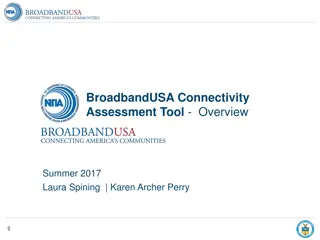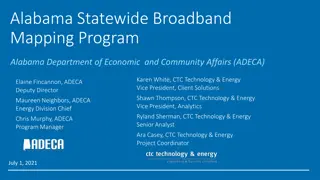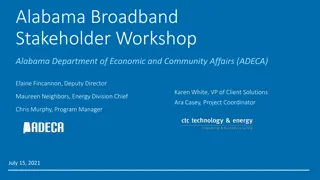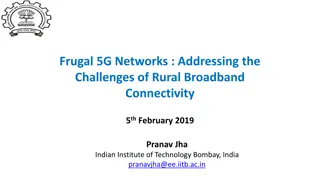Rural Broadband ID Grant
The document titled "Rural.Broadband.ID.GrantSample.WalkthroughJoseph.Sanford,.MD" provides a detailed walkthrough and overview of a sample grant related to rural broadband initiatives. It includes information on the application process, eligibility criteria, and key considerations for applicants seeking funding for broadband projects in rural areas. The document offers insights into the essential components of grant applications and tips for a successful submission.
Download Presentation

Please find below an Image/Link to download the presentation.
The content on the website is provided AS IS for your information and personal use only. It may not be sold, licensed, or shared on other websites without obtaining consent from the author.If you encounter any issues during the download, it is possible that the publisher has removed the file from their server.
You are allowed to download the files provided on this website for personal or commercial use, subject to the condition that they are used lawfully. All files are the property of their respective owners.
The content on the website is provided AS IS for your information and personal use only. It may not be sold, licensed, or shared on other websites without obtaining consent from the author.
E N D
Presentation Transcript
Rural Broadband ID Grant Sample Walkthrough Joseph Sanford, MD
What is the Rural Broadband I.D. Grant? It s a one-time grant to pay for the cost of a study to determine if broadband is needed in an area and the expenses needed to get it there. Essential Resources: The Rural Broadband ID Grant Notice of Funding Opportunity https://idhi.uams.edu/rural-broadband-grant/grant-description/ Rural Broadband ID Grant FAQ page https://idhi.uams.edu/rural-broadband-grant/grant-faqs/ Broadband Resources webpage for helpful toolkits and guidelines **NEW A Sample Application is now available here** https://idhi.uams.edu/rural-broadband-grant/broadband-resources/
How to Define Your Proposed Service Area List the counties, unincorporated communities, cities, or incorporated towns to be served through this proposal. If you will serve an entire county, only list the county name. If you will serve multiple counties, list each county name. If you will only serve one community, city, or town, only list that name. If you will serve certain communities, cities, or towns in a county, list all applicable. No map is required for this response; however, you may use a map with a boundary line to indicate your proposed service area. Here is an example taken from Google Maps (https://www.google.com/maps):
How to Determine your 25/3 Broadband Availability This is best achieved through two related maps and legends. Go to https://broadbandmap.fcc.gov/#/ Map 1: Search by Address Once you enter your address or area, you will be taken to the Location Summary page with a map and list of Internet Service Providers. Map 2: Search by Area You will be directed to a page that has a search box with a drop-down menu to search by State, County, Congressional District, Census Place, Tribal Area, or CBSA (Core-Based Statistical Areas, which includes large and medium sized areas).
How to Determine Your Total Population 1. Go to https://www.census.gov/data.html 2. Enter your city, town, place, county, etc. in the search bar. Hit Search. 3. The total population will appear in the topmost text box. 4. If you have multiple places or counties in your application, please repeat this process for each one. Feel free to list the populations in narrative or table form. 5. If you do not see your place listed on this site, please choose the nearest, larger place. For example, for Furlow, Arkansas, you may choose Lonoke, Arkansas.
How to Determine the Rurality of Your Proposed Area If you are proposing a place: If the place population is 2,500 or less, that place is 100% rural. If the place population is over 2,500 but under 50,000, that place is 100% urban cluster. If the place population is over 50,000, that place is 100% urban. If you are proposing a county: Go to https://local.arkansas.gov/index.php Under the county pull-down menu, select your targeted county. This will take you to a county summary. Scroll down to Cities in XXX County. All other places in the county would be considered rural. If you are proposing multiple places, counties, or a mixture thereof: Repeat these steps as necessary for each place or county. Provide a summary of your findings to represent the rurality of your proposed area. If you must estimate the total percent of rural and urban, please just provide the data on which you made that estimate.
How to Determine Population Living in Poverty 1. Go to https://www.census.gov/data.html 2. Enter your city, town, place, county, etc. in the search bar. Hit Search. 3. Select the blue box Profile on the far right of the page. 4. The Poverty Rate will appear near the top of the profile page, under an icon that looks like this: 5. If you have multiple places or counties in your application, please repeat this process for each place or county. Feel free to list the populations in narrative or table form.
How to Determine Medically Underserved Areas By county MUA determination: 1. Go to https://data.hrsa.gov/tools/shortage-area/mua-find 2. On the leftmost column, select Arkansas. 3. On Select County(s) required, select the location of your proposed area s county. 4. Once you click Submit, you will see a table with information. The Cross or Plus icons on the right most column will pull down a list of Medically Underserved Areas. If you have many rows of information, which may occur in some urban counties, please screen capture what you can fit in your window to give reviewers a good idea of your MUAs. 5. Screen shot these tables for your response. By address MUA determination: 1. Go to https://data.hrsa.gov/tools/shortage-area/by-address 2. Under Search Criteria enter an address in your proposed service area. You may use any address that falls within your proposed service area. 3. You may take a screen shot or write down the information provided about MUAs that appear on the left side of the screen.
Example Information on Staffing Needs While any content will be acceptable to describe staffing needs, the following are a few things you may consider including to describe existing experience or lack of staff experience: Working with Internet Service Providers Educating or communicating with your residents Experience with technology or broadband Social media experience Working with contractors and consultants Or any other experience you find relevant. Writing grant or loan applications Managing state or federal funds Managing and balancing budgets Maintaining timelines and meeting deadlines Convening committees Carrying out special projects Hiring personnel
Example Information on Population Needs While any content will be acceptable to describe population needs, the following are a few things you may consider including: Demographic info like race, ethnicity, age, income Any known business needs (e.g. ability to conduct e- commerce, businesses that have closed or will shut down, businesses that have moved and relocated elsewhere, lack of workforce, lack of training resources, struggling economies, etc.) Schools in your area Healthcare providers, clinics, emergency medical services, or hospitals in your area Any known educational needs (e.g. students cannot access online curriculum, graduates cannot access online college coursework, adults cannot participate in online training or education, etc.) Any known healthcare needs (e.g. residents with chronic health problems, inaccessibility to nearby healthcare providers, residents who lack insurance, etc.)
Example Information on Broadband Needs While any content will be acceptable to describe these needs, the following are a few things you may consider including: Any observed variances or personal disagreements in broadband access or speed compared to the FCC coverage map you completed in the first section. How your residents could benefit, possibly including: Educational attainment Economy / community revenue Retained jobs / retained businesses Primary or specialty healthcare access Entertainment options Communications between first responders How broadband access or speed has impacted your: Schools Businesses Residents Community facilities Healthcare facilities
Example Information on Internet Service Provider Relationships While any content will be acceptable to describe these needs, the following are a few things you may consider including: Any past communication with ISPs about your community needs Any agreements or disagreements with ISPs about your community needs Any perspective on customer services provided by current ISPs Any alliances your community has made with ISPs It is also perfectly acceptable to have no past relationship or communication with ISPs.
Example Information on Financial Needs While any content will be acceptable to describe these needs, the following are a few things you may consider including: Your current annual budget for your community. If proposing multiple communities: The average annual budget of the communities you plan to serve through this proposal, or An itemized list of the annual budgets of the communities you plan to serve through this proposal. What that budget covers (fire, police, city salaries, etc.) Why this grant may be financially needed, possibly including: Your budget is limited in what it can cover A budget reallocation for these activities would require council approval and may not result in such an approval Some council or civic members do not appreciate the importance of spending money on broadband or broadband planning Other financial needs are more pressing at this time
Example Information on Community Relationship Needs While any content will be acceptable to describe these needs, the following are a few things you may consider including: A summary of any past discussions with community leaders about broadband Whether your community leader(s) support the idea of improving broadband Whether any resident or community organization has approached your leaders to appeal for improved broadband
How to Describe Your Plan While any format will be acceptable to describe your proposed plan, the following is a format you may use to describe your plan: Summary of your proposed activities. Provide a list of any contractors or consultants you have considered hiring through grant funds. It is acceptable if you have not selected contractors or consultants. Provide a timeline of these activities. Some examples of these may include: Contract with an Internet Service Provider to perform a feasibility study for your area. Hire a Certified Public Accountant to perform audits and other financial analyses required for grant proposals. Order construction plans for broadband deployment. Hire a contractor to analyze federal broadband grant and loan opportunities. Form a Broadband Taskforce. Conduct a community-wide broadband needs assessment. Contract with another local government or electrical cooperatives to provide coaching. Secure consultative support to learn about broadband and the options available to your community. Secure legal support to better negotiate and mediate with Internet Service Providers and/or Electric Cooperatives. Participate in community education to improve understanding of broadband and grant writing. Hire a contractor to pursue federal broadband funding grants and loans.
How to Describe Your Plan While any format will be acceptable to describe your proposed plan, the following is a format you may use to describe your plan: List your final products for the broadband due diligence study. These are items that will come into being because of the funding you received and the activities you conducted. Some examples may include: A broadband feasibility study prepared by a contracted ISP A 20-year break-even analysis prepared by a contracted Certified Public Accountant A financial audit prepared by a contracted Certified Public Accountant Construction plans prepared by a contracted broadband construction company A written analysis of broadband grants and loans that may fulfill your needs from a contracted grants researcher A written needs assessment authored by a Broadband Taskforce or other community source Any support materials provided by a contractor that coached or educated your leaders or community on broadband Any legal agreements or materials that secure Internet Service Provider services or future services Any federal broadband grant or loan proposals, even in draft form, that were produced by a grant writer during this Rural Broadband I.D. grant period.
How to Describe Your Plan While any format will be acceptable to describe your proposed plan, the following is a format you may use to describe your plan: List any federal broadband grants or loans you have considered pursuing. It is acceptable if you have not considered any of this grants or loans. If you want to investigate some opportunities, here are some opportunities: https://www.usda.gov/reconnect https://www.rd.usda.gov/programs-services/rural-economic-development-loan-grant-program https://www.ncta.com/k12bridge-to-broadband https://www.fcc.gov/document/fcc-proposes-5g-fund-rural-america-0 https://www.imls.gov/grants/available/national-leadership-grants-libraries https://www.rd.usda.gov/sites/default/files/USDA_RDSA_COVID-19CUMULATIVEFactsheet_09_09_2020.pdf
How to Budget the Proposal While any format will be acceptable to budget your proposal, the SF-424A budget provided on the Rural Broadband I.D. website automatically totals your request. You should only fill out Section B. Personnel: This will include anyone who will work on the grant activities and 1) are currently on your payroll or 2) will be added to the payroll. Fringe Benefits: These only apply to the personnel on your grant and can cover their healthcare benefits, dental benefits, life insurance, or other benefits provided to your personnel. Typically this is shown as a percentage of the annual salary. Travel: This can include in-state travel, providing mileage reimbursement as needed to carry out grant activities. This may also include out-of- state travel should the applicant decide to seek broadband education or consultation in another state. Equipment: This may include any item that exceeds $5,000 per unit cost as needed to carry out the activities of the project. Supplies: This may include office supplies, printing, postage, rental space for meetings, laptops and computers, and other items needed to carry out the activities of the project. Contractual: This is the cost of any contracted consultants, Internet Service Providers, Electric Cooperatives, writers, or any person or group who will complete activities in the grant but are not on the applicant s payroll. If you are partnering with another local entity, you can also allocate money to that other entity as a contractor, documenting that cost here. Other: Anything you do not feel fits nicely into one of the categories above may be included here.
How to Justify Your Budget While any format will be acceptable to budget your proposal, the SF-424A budget provided on the Rural Broadband I.D. website automatically totals your request. You should only fill out Section B. Personnel: Name the person, position, and annual salary / hourly wage. Identify the number of hours or percent of effort for the project and describe what they will do. Fringe Benefits: Identify your fringe benefit rate for personnel Travel: Identify the miles you intend to travel and the per-mile travel reimbursement requested. Itemize any out-of-state travel by specifying the cost of airfare and boarding. Describe why travel is necessary to the activities of your project. Equipment: Itemize any equipment over $5,000 per unit and describe why this equipment is necessary to the activities of your project. Supplies: Itemize any supplies and their cost and describe how these supplies will be used to carry out the project. Contractual: Identify any contractors or consultants you wish to hire, specify the requested costs for each contractor or consultant. Describe what kind of work these contractors or consultants will be conducting for your project. It is acceptable if you do not have contractors or consultants selected and are just requesting a specified amount to pay the contractor or consultant once identified. Other: Itemize any other items or services needed and their associated costs and describe why these other items are needed to compete your project.
Other Items Supporting Documents Templates While any letter format you wish to use for the supporting document is acceptable, we provide a few letter templates you may feel free to use and customize as you wish in the supplemental guidance document. If you need more help Send questions by email: idhi@uams.edu Or phone: 1-855-234-3348 Seeking a Hardship If you wish to seek a hardship in answering any question due to lack of broadband access or a knowledge of the Internet to access the answers, please call 855-234-3348. Leave your name and phone number, and please indicate you are filing a request for hardship. You will receive a follow-up phone call.
